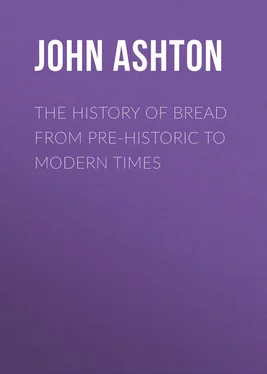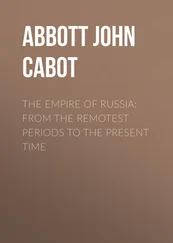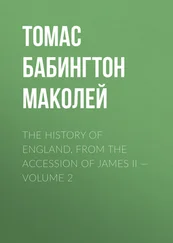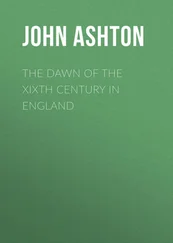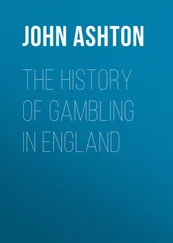John Ashton - The History of Bread From Pre-historic to Modern Times
Здесь есть возможность читать онлайн «John Ashton - The History of Bread From Pre-historic to Modern Times» — ознакомительный отрывок электронной книги совершенно бесплатно, а после прочтения отрывка купить полную версию. В некоторых случаях можно слушать аудио, скачать через торрент в формате fb2 и присутствует краткое содержание. Жанр: foreign_antique, foreign_prose, на английском языке. Описание произведения, (предисловие) а так же отзывы посетителей доступны на портале библиотеки ЛибКат.
- Название:The History of Bread From Pre-historic to Modern Times
- Автор:
- Жанр:
- Год:неизвестен
- ISBN:нет данных
- Рейтинг книги:3 / 5. Голосов: 1
-
Избранное:Добавить в избранное
- Отзывы:
-
Ваша оценка:
- 60
- 1
- 2
- 3
- 4
- 5
The History of Bread From Pre-historic to Modern Times: краткое содержание, описание и аннотация
Предлагаем к чтению аннотацию, описание, краткое содержание или предисловие (зависит от того, что написал сам автор книги «The History of Bread From Pre-historic to Modern Times»). Если вы не нашли необходимую информацию о книге — напишите в комментариях, мы постараемся отыскать её.
The History of Bread From Pre-historic to Modern Times — читать онлайн ознакомительный отрывок
Ниже представлен текст книги, разбитый по страницам. Система сохранения места последней прочитанной страницы, позволяет с удобством читать онлайн бесплатно книгу «The History of Bread From Pre-historic to Modern Times», без необходимости каждый раз заново искать на чём Вы остановились. Поставьте закладку, и сможете в любой момент перейти на страницу, на которой закончили чтение.
Интервал:
Закладка:
At first, in all probability, the normal course of pre-historic man was followed – wheat and barley grew wild, were first eaten raw, and then parched. Of this latter and primitive method of cooking cereals we have several notices. It was used as a sacrifice, as we see in Leviticus ii. 16: ‘And the priest shall burn the memorial of it, part of the beaten corn thereof, and part of the oil thereof, with all the frankincense thereof: it is an offering made by fire unto the Lord.’ That parched corn was at that time a food we find in Levit. xxiii. 14: ‘And ye shall eat neither bread, nor parched corn, nor green ears, until the self-same day that ye have brought an offering unto your God.’ We next find it as the food of labouring people in Ruth ii. 14, when Boaz ‘reached her parched corn, and she did eat, and was sufficed, and left.’
Mention is again made of it in I. Sam. xvii., when Goliath of Gath challenged the men of Israel. Jesse’s three sons had followed Saul to the battle, and the anxious father had sent his youngest son David, with provisions for them, and a present to their commander, vv. 17, 18: ‘And Jesse said unto David his son, Take now for thy brethren an ephah 4 4 A measure containing 10 homers, or about 60 pints.
of this parched corn, and these ten loaves, and run to the camp to thy brethren; and carry these ten cheeses unto the captain of their thousand, and look how thy brethren fare, and take their pledge.’ We see, I. Sam. xxv. 18, how Abigail, Nabal’s wife, in order to propitiate David, ‘made haste, and took 200 loaves, and two bottles of wine, and five sheep ready dressed, and five measures of parched corn, and 100 clusters of raisins, and 200 cakes of figs, and laid them on asses.’ The last we hear of parched corn as food is in II. Sam. xvii. 27, 28, when David arrived at Mahanaim. Shobi, Machir, and Barzillai ‘brought beds, and basons, and earthen vessels, and wheat, and barley, and flour, and parched corn, and beans, and lentils, and parched pulse.’ In England this parching is sometimes applied to peas, and, indeed, there is a saying comparing an extremely lively person ‘to a parched pea in a frying pan,’ and in America ‘pop corn,’ or parched maize, is very popular.
Threshing corn we first read of in Deut. xxv. 4, when we find the following direction given: ‘Thou shalt not muzzle the ox when he treadeth out the corn,’ a practice which the natives of Aleppo, and some other Eastern places, still religiously observe.
How Gideon (Jud. vi. 11) or Oman (I. Chron. xxi. 20) threshed, whether by oxen or by flail, we cannot tell, but in Isaiah xxviii. 27, 28, we find five methods of threshing then in vogue. ‘For the fitches [this is supposed to be the Nigella sativa , whose seeds are used as a condiment, like coriander or caraway] are not threshed with a threshing instrument, neither is a cart wheel turned about upon the cummin; but the fitches are beaten out with a staff, and the cummin with a rod. Bread corn is bruised; because he will not ever be threshing it, nor break it with the wheel of his cart, nor bruise it with his horsemen.’ In Lowth on Isaiah we find this passage made somewhat clearer:
‘The dill is not beaten out with the corn-drag ;
Nor is the Wheel of the Wain made to turn upon the cummin.
But the dill is beaten out with the Staff ,
And the cummin with the Flail , but
The bread corn with the Threshing-Wain ;
And not for ever will he continue thus to thresh it,
Nor vex it with the Wheel of its Wain,
Nor to bruise it with the Hoofs of his Cattle .’
The Staff and Flail were used for that grain that was too tender to be treated in any other method. The Drag consisted of a sort of frame of strong planks, made rough at the bottom with hard stones or iron; it was drawn by horses or oxen over the corn sheaves spread on the threshing floor, the driver sitting upon it. The Wain was much like the former, but had wheels with iron teeth, or edges like a saw; the axle was armed with iron teeth or serrated wheels throughout; it moved upon three rollers, armed with iron teeth, or wheels, to cut the straw. In Syria they make use of the drag constructed in the very same manner – and this not only forces out the grain, but cuts the straw in pieces for fodder for the cattle; for in Eastern countries there is no hay.
Sir R. K. Porter, in his Travels in Georgia , 5 5 Vol. II., 89.
speaks of this method of threshing, which he saw in the early part of the last century. ‘The threshing operation is managed by a machine composed of a large square frame of wood, which contains two wooden cylinders placed parallel to each other, and which have a turning motion. They are stuck full of splinters, with sharp square points, but not all of a length. These barrels have the appearance of the barrels in an organ, and their projections, when brought in contact with the corn, break the stalk and disengage the ear. They are put in motion by a couple of cows or oxen, yoked to the frame, and guided by a man sitting on the plank that covers the frame which contains the cylinders. He drives this agricultural equipage in a circle round any great accumulation of just-gathered harvest, keeping at a certain distance from the verge of the heap, close to which a second peasant stands, holding a long-handled 20-pronged fork, shaped like the spread sticks of a fan, and with which he throws the unbound sheaves forward to meet the rotary motion of the machine. He has a shovel also ready, with which he removes to a considerable distance the corn that has already passed the wheel. Other men are on the spot with the like implement, which they fill with the broken material, and throw it aloft in the air, where the wind blows away the chaff, and the grain falls to the ground. The latter process is repeated till the corn is completely winnowed from its refuse, when it is gathered up, carried home, and deposited for use in large earthen jars. The straw is preserved with care, being the sole winter food of the horses and mules. But while I looked on at the patriarchal style of husbandry, and at the strong yet docile animal, which for so many ages had been the right hand of man in his business of tilling and reaping the ground, I could not but revere the beneficent law which pronounced, “Muzzle not the ox when he treadeth out the corn.”’
It was probably one of these that Araunah meant (II. Sam. xxiv. 22) when he said unto David: ‘Let my lord the king take and offer up what seemeth good unto him: behold, here be oxen for burnt sacrifice, and threshing instruments and other instruments of the oxen for wood.’ And it is certainly mentioned in Isaiah xli. 15: ‘Behold, I will make thee a new sharp threshing instrument having teeth.’
The threshing-floor is many times mentioned in the Bible. There were those of Atad, Nachon, and Araunah (or Ornan), the value of whose floor, etc., is variously stated in II. Sam. xxiv. 24, where it says that David bought the flour and oxen for 50 shekels of silver, or about 6 l of our money; whilst in I. Chron. xxi. 25, he gave him 600 shekels of gold in weight, or 1200 l of our currency, which seems a large sum for a small level piece of ground; for the floors, so-called, were out of doors, so that the wind might carry away the chaff, as we read in Hosea xiii. 3: ‘They shall be … as the chaff that is driven with the whirlwind out of the floor.’ See also Psalm i. 4.
These floors were used for other purposes than threshings, as we read in I. Kings xxii. 10: ‘And the king of Israel and Jehoshaphat the king of Judah sat each on his throne, having put on their robes, in a void place ( or floor ) in the entrance of the gate of Samaria; and all the prophets prophesied before them,’ a statement which is repeated in II. Chron. xviii. 9.
Читать дальшеИнтервал:
Закладка:
Похожие книги на «The History of Bread From Pre-historic to Modern Times»
Представляем Вашему вниманию похожие книги на «The History of Bread From Pre-historic to Modern Times» списком для выбора. Мы отобрали схожую по названию и смыслу литературу в надежде предоставить читателям больше вариантов отыскать новые, интересные, ещё непрочитанные произведения.
Обсуждение, отзывы о книге «The History of Bread From Pre-historic to Modern Times» и просто собственные мнения читателей. Оставьте ваши комментарии, напишите, что Вы думаете о произведении, его смысле или главных героях. Укажите что конкретно понравилось, а что нет, и почему Вы так считаете.
